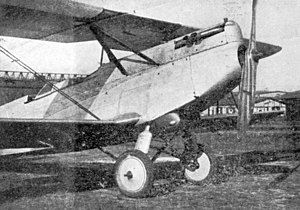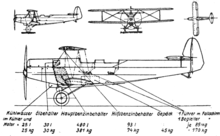| L 75 Ass | |
|---|---|

| |
| Role | Trainer |
| Manufacturer | Albatros Flugzeugwerke |
| Designer | Walter Blume |
| First flight | 1928 |
| Number built | 43 |
The Albatros L 75 Ass (German: "Ace") was a German trainer biplane of the 1920s. Of conventional configuration, it seated the pilot and instructor in separate, open cockpits. The wings were single-bay, equal-span, and had a slight stagger. Production continued after Albatros was absorbed by Focke-Wulf.
Variants
[edit]- L 75 - prototype with BMW IVa engine
- L 75a - production version with BMW Va engine
- L 75b - with Junkers L5 engine
- L 75c - BMW Va engine
- L 75d - BMW Va engine
- L 75E - BMW Va engine
- L 75F - Junkers L5G engine
- L 75DSA - BMW Va engine
- L 75DSB - Junkers L5 engine
Operators
[edit]Specifications (L 75a)
[edit]
Data from Jane's all the World's Aircraft 1928,[1] German Aircraft between 1919–1945[2]
General characteristics
- Crew: 2
- Length: 10 m (32 ft 10 in)
- Wingspan: 12.5 m (41 ft 0 in)
- Height: 3.25 m (10 ft 8 in)
- Wing area: 37 m2 (400 sq ft)
- Empty weight: 1,150 kg (2,535 lb)
- Gross weight: 1,835 kg (4,045 lb)
- Fuel capacity: 480 L (130 US gal; 110 imp gal) main, 93 L (25 US gal; 20 imp gal) in reserve gravity-feed tank
- Powerplant: 1 × BMW Va six-cylinder in-line water-cooled piston engine, 270 kW (360 hp) for take-off 240 kW (320 hp) continuous
- Propellers: 2-bladed fixed pitch propeller
Performance
- Maximum speed: 217 km/h (135 mph, 117 kn)
- Cruise speed: 170 km/h (110 mph, 92 kn)
- Landing speed: 90 km/h (56 mph; 49 kn)
- Range: 1,600 km (990 mi, 860 nmi)
- Service ceiling: 5,500 m (18,000 ft)
- Time to altitude: 1,000 m (3,300 ft) in 7 minutes
- Wing loading: 59.8 kg/m2 (12.2 lb/sq ft)
- Power/mass: 0.1141 kW/kg (0.0694 hp/lb)
References
[edit]- ^ Grey, C.G., ed. (1928). Jane's all the World's Aircraft 1928. London: Sampson Low, Marston & company, ltd. p. 128c.
- ^ "Albatros L 75". histaviation.com. Retrieved 9 February 2018.
Further reading
[edit]- Taylor, Michael J. H. (1989). Jane's Encyclopedia of Aviation. London: Studio Editions. p. 56.
Well, that’s interesting to know that Psilotum nudum are known as whisk ferns. Psilotum nudum is the commoner species of the two. While the P. flaccidum is a rare species and is found in the tropical islands. Both the species are usually epiphytic in habit and grow upon tree ferns. These species may also be terrestrial and grow in humus or in the crevices of the rocks.
View the detailed Guide of Psilotum nudum: Detailed Study Of Psilotum Nudum (Whisk Fern), Classification, Anatomy, Reproduction